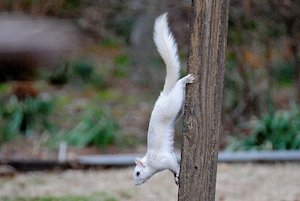
By Terry W. Johnson
Most homeowners who feed birds in their backyards consider gray squirrels a nemesis. Squirrels eat more than their share of the food put out for birds and then add insult to injury by gnawing on the feeders. Indeed, the war on squirrels is constantly fought on many fronts throughout the entire state.
However, how would you feel if a white squirrel suddenly showed up at your feeder? Would you treat it with the same disdain you do a normal-colored gray squirrel? Probably not. If you are like most people fortunate enough to see a white squirrel, you would probably treat it as something very special. In fact, many communities that have white squirrels proudly proclaim they are the Home of the White Squirrels.
Small populations of white squirrels live in a number of widely separated locations across the country, from California and Texas to Illinois, North Carolina and Florida. For some reason, white squirrels seem more abundant in Illinois than any other state.
More often than not, when white squirrels appear, people roll out the red carpet for them. In Olney, Ill., a city ordinance protecting the squirrels has been on the books since 1902. The patch worn by Olney police officers bears the likeness of a white squirrel. The same police vigorously enforce local ordinances that give white squirrels the right-of-way on city streets. And anyone caught trying to trap or sell a white squirrel faces a $500 fine.
Some communities have learned that white squirrels often mean tourist dollars. For example, Brevard, N.C., has an annual White Squirrel Festival.
There is even an Albino Squirrel Preservation Society. It was founded in 2001 by folks concerned that the population of white squirrels on the campus of University of Texas was declining.
I had never seen a white squirrel until about four years ago when I visited a Warner Robins couple who are backyard wildlife enthusiasts. There, in a quiet neighborhood within the city limits, white squirrels are routinely seen eating sunflower from feeders and foraging for acorns and other seeds on lawns. The couple told me that since the squirrels were first spotted in 2003, the numbers of white squirrels they see varies from year to year. That particular winter they had seen no more than four of the eye-catching animals. Over the years, the most they had seen was seven.
There are two basic types of white squirrels: albino and leucistic. Albinos have pink or blue eyes and no dark pigments anywhere on their bodies. Squirrels that have white coats and dark eyes are called leucistic. Another type of white squirrel is predominantly white and sports a dark head patch and stripe on its back. The white-phase gray squirrel I saw a few years ago was leucistic.
Albino gray squirrels are the rarest form of white squirrel. Mammalogists estimate that the odds of a female gray squirrel giving birth to an albino offspring are 1 in 100,000. The scarcity of albino squirrels is thought to be at least partially linked to the animal’s lack of any dark eye pigment: This leaves them more susceptible to the harmful effects of sun rays, which can permanently damage their eyes. In turn, their poor eyesight makes them more likely to suffer injury and death by falling out of trees.
Because white squirrels lack the camouflage offered by the gray/brown pelage of a typical gray squirrel, you would think they would be more susceptible to predators. Yet some experts say that may not be the case. They argue that hawks and other wild predators may not recognize a white squirrel as food.
The theory doesn’t seem to apply where domestic cats are concerned. Declines in white squirrels living in Olney, Ill., have been blamed on cat predation.
There are a couple of ways that white squirrels—the leucistic kind—suddenly appear in an area. Scientists believe that occasionally squirrels are born without the genes that enable their bodies to produce normal amounts of a chemical known as melanin. A squirrel’s hair color is determined by the amount of melanin in its hair cells. Squirrels that produce too much melanin are black. Those with too little melanin are white. Squirrels that produce only moderate levels of pigment are blond.
Over the years, people have trapped white squirrels and released them in other areas. For example, it is widely believed that the white squirrel colony in Brevard, N.C., got its start from white squirrels trapped in a pecan grove in Madison County, Fla., and released in Brevard. (Note: In Georgia, as in most states, trapping and relocating native wildlife without a permit is illegal.)
Some white squirrel colonies are short-lived, disappearing in a few years. The Olney, Ill., colony is a notable exception. White squirrels have been seen in this community since the 1800s.
Usually, such populations include 20 or fewer squirrels, and they comprise less than 10 percent of the local squirrel population. However, it has been reported that one in three gray squirrels in Brevard, N.C., is white.
For me, seeing a white squirrel was a treat. I wish we had colonies of naturally occurring white squirrels in more parts of the Peach State. It would give Georgians a greater opportunity to see one of Nature’s most unusual yet beautiful oddities.
Terry W. Johnson is a former Nongame program manager with the Wildlife Resources Division and executive director of The Environmental Resources Network, or TERN, friends group of the division’s Nongame Conservation Section. (Permission is required to reprint this column.) Learn more about TERN, see previous “Out My Backdoor” columns, read Terry’s Backyard Wildlife Connection blog and check out his latest book, “A Journey of Discovery: Monroe County Outdoors.”



















